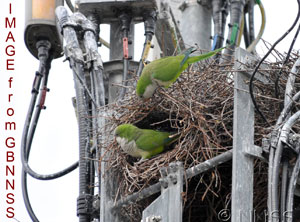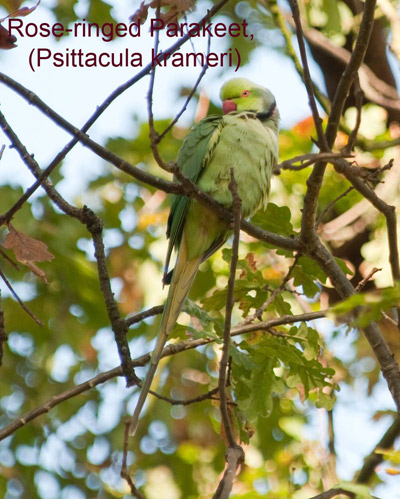Invasive species : Monk parakeets?

DEFRA has declared that the monk parakeet is a threat. The home of the monk parakeet is South America. It is being viewed as a threat because of the parakeet’s unusual nesting habits. Unlike other parrots, monk parakeets (Myiopsitta monachus) use sticks to build huge nests on the outside of a tree’s canopy or pylons – these can reach the size of a small car! In the United States, the nests have been responsible for power shortages, cuts in power transmission, fires and crop damage. However, no damage in the U.K. has been reported to date though DEFRA has expressed concern that damage might be caused to ‘national infra-structure’ and native British wildlife.
Small populations of the monk parakeet have occurred in various parts of the country but they have proved to be not self-sustaining. However, there are probably three colonies / populations in and around London; one in Borehamwood (Herts), another on the Isle of Dogs in London, and possibly a small population in Southall (Middx). To date, the numbers of the monk parakeet are not great but (it has been argued) numbers could rise very quickly given the ‘ease’ with which they adapt to life in cities and to different climates.
The bird is very noisy, with iridescent green and blue plumage, with an orange beak. It has life span of up to thirty years. Its appearance is not dis-similar to that of the ring necked parakeet, which are often seen in parks and gardens. DEFRA is planning a cull that will involve trapping and nest removal of the birds, and possibly shooting. Not everyone is happy with the decision - suggesting that various people / bodies have over-stated the damage or threat of damage from these birds.
DEFRA has made various calculations as to the cost of invasive non native species in the UK quote
“The total current annual cost of INNS to the British economy is estimated, when corrected for double counting, at £1,291,461,000 to England, £244,736,000 to Scotland and £125,118,000 to Wales. Therefore the total annual cost of INNS to the British economy is estimated at approximately £1.7 billion.”
NOTE : To be distinguished from
Psittacula krameri - the rose ringed parakeet
Image below courtesy of DEFRA : Non-Native Species Secretariat
Comments are closed for this post.
Discussion
Multitudes of green, collared parakeets seen in Hampstead Heath. Concerned they affect the small wild birds native to our country. I noticed something especial: maybe my imagination but: Trying to imitate our local birds’ songs!
Am also very worried that all birds are being directly affected by the web of radiation caused by all our mobile phones (and other equipment?).
Am used to plenty of birds flying in my childhood, plenty in past years even in my tiny london garden, but last two-three years, they have dropped alarmingly. No dawn chorus.
Please investigate.


Hi Annalouise
I think the parakeets you see are Ring necked, there is a video here that I took in Surrey. I have heard that there is some concern about how well they are doing and the competition that they present for local birds, but no one seems very sure.
http://peplers.blogspot.com/2011/12/ring-necked-parakeets-in-wild-in-surrey.html
Tracy
26 January, 2012